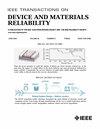Cohesive Zone Parameters Extraction for Sintered Nano Ag/Al Joints With the Different Surface Finish Layers Under High Temperature Aging
IF 2.5
3区 工程技术
Q2 ENGINEERING, ELECTRICAL & ELECTRONIC
IEEE Transactions on Device and Materials Reliability
Pub Date : 2024-12-09
DOI:10.1109/TDMR.2024.3513318
引用次数: 0
Abstract
Because of its outstanding advantages, sintered nano silver is considered the most promising interconnect material in power module packaging such as silicon carbide (SiC). In view of the wettability of the interface between sintered nano silver and metal substrate, the influence of the metallization layer, which is adopted to improve the wettability of the interface between sintered nanosilver and metal substrate, on the interface bonding strength has also become a research focus. In this paper, a cohesive zone model (CZM), which can describe the failure damage and shear fracture process, is used to predict the bonding strength of “sandwich” structures with different metallization layers based on the die shear test. Considering the effect of high temperature aging, the mechanism of different substrate metallization and high temperature aging conditions on the shear strength of sintered silver interconnect layer was presented. Based on the fracture surface morphology of sintered silver adhesive joint, the mechanism of bonding strength of samples with different metallization layers changes with high temperature aging is verified. In addition, the CZM model and related parameters proposed in this paper can be directly used to evaluate the reliability of sintered Ag-Al interface in power device applications.不同表面光洁度层烧结纳米银/铝接头在高温老化条件下的内聚区参数提取
由于其突出的优点,烧结纳米银被认为是与碳化硅(SiC)等功率模块封装中最有前途的互连材料。针对烧结纳米银与金属基板界面的润湿性,为提高烧结纳米银与金属基板界面的润湿性而采用的金属化层对界面结合强度的影响也成为研究热点。本文基于模具剪切试验,建立了一种能够描述失效损伤和剪切断裂过程的内聚区模型(CZM),用于预测不同金属化层的“三明治”结构的结合强度。考虑高温时效的影响,探讨了不同基体金属化程度和高温时效条件对烧结银互连层抗剪强度的影响机理。基于烧结银胶接头断口形貌,验证了不同金属化层试样的结合强度随高温时效变化的机理。此外,本文提出的CZM模型及相关参数可直接用于功率器件中烧结Ag-Al界面的可靠性评估。
本文章由计算机程序翻译,如有差异,请以英文原文为准。
求助全文
约1分钟内获得全文
求助全文
来源期刊

IEEE Transactions on Device and Materials Reliability
工程技术-工程:电子与电气
CiteScore
4.80
自引率
5.00%
发文量
71
审稿时长
6-12 weeks
期刊介绍:
The scope of the publication includes, but is not limited to Reliability of: Devices, Materials, Processes, Interfaces, Integrated Microsystems (including MEMS & Sensors), Transistors, Technology (CMOS, BiCMOS, etc.), Integrated Circuits (IC, SSI, MSI, LSI, ULSI, ELSI, etc.), Thin Film Transistor Applications. The measurement and understanding of the reliability of such entities at each phase, from the concept stage through research and development and into manufacturing scale-up, provides the overall database on the reliability of the devices, materials, processes, package and other necessities for the successful introduction of a product to market. This reliability database is the foundation for a quality product, which meets customer expectation. A product so developed has high reliability. High quality will be achieved because product weaknesses will have been found (root cause analysis) and designed out of the final product. This process of ever increasing reliability and quality will result in a superior product. In the end, reliability and quality are not one thing; but in a sense everything, which can be or has to be done to guarantee that the product successfully performs in the field under customer conditions. Our goal is to capture these advances. An additional objective is to focus cross fertilized communication in the state of the art of reliability of electronic materials and devices and provide fundamental understanding of basic phenomena that affect reliability. In addition, the publication is a forum for interdisciplinary studies on reliability. An overall goal is to provide leading edge/state of the art information, which is critically relevant to the creation of reliable products.
 求助内容:
求助内容: 应助结果提醒方式:
应助结果提醒方式:


